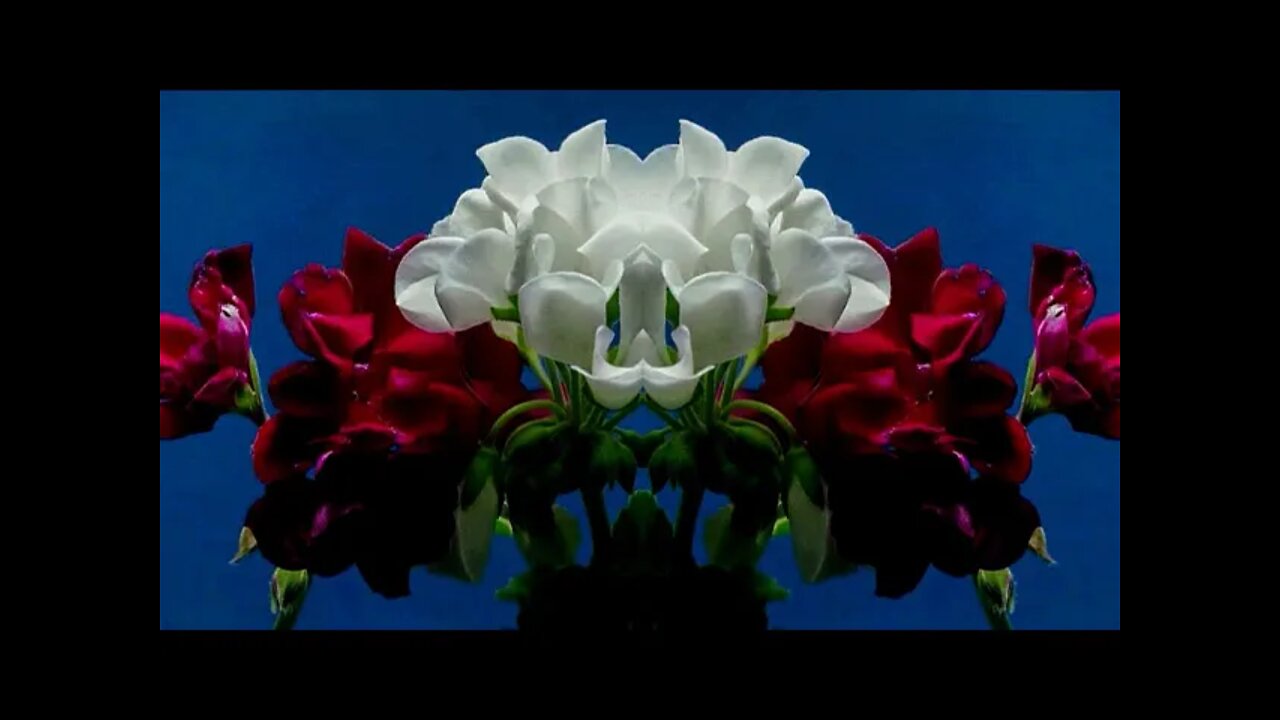Premium Only Content

The Worlds Most Beautiful Flowers Blooming.
A flower, sometimes known as a bloom or blossom, is the reproductive structure found in flowering plants (plants of the division Angiospermae). The biological function of a flower is to facilitate reproduction, usually by providing a mechanism for the union of sperm with eggs. Flowers may facilitate outcrossing (fusion of sperm and eggs from different individuals in a population) resulting from cross-pollination or allow selfing (fusion of sperm and egg from the same flower) when self-pollination occurs.
A flower, sometimes known as a bloom or blossom, is the reproductive structure found in flowering plants (plants of the division Angiospermae). Flowers produce gametophytes, which in flowering plants consist of a few haploid cells which produce gametes. The "male" gametophyte, which produces non-motile sperm, is enclosed within pollen grains; the "female" gametophyte is contained within the ovule. When pollen from the anther of a flower is deposited on the stigma, this is called pollination. Some flowers may self-pollinate, producing seed using pollen from the same flower or a different flower of the same plant, but others have mechanisms to prevent self-pollination and rely on cross-pollination, when pollen is transferred from the anther of one flower to the stigma of another flower on a different individual of the same species.
Self-pollination happens in flowers where the stamen and carpel mature at the same time, and are positioned so that the pollen can land on the flower's stigma. This pollination does not require an investment from the plant to provide nectar and pollen as food for pollinators.[1]
Some flowers produce diaspores without fertilization (parthenocarpy). Flowers contain sporangia and are the site where gametophytes develop.
Most flowering plants depend on animals, such as bees, moths, and butterflies, to transfer their pollen between different flowers, and have evolved to attract these pollinators by various strategies, including brightly colored, conspicuous petals, attractive scents, and the production of nectar, a food source for pollinators.[2] In this way, many flowering plants have co-evolved with pollinators to be mutually dependent on services they provide to one another—in the plant's case, a means of reproduction; in the pollinator's case, a source of food.[3] After fertilization, the ovary of the flower develops into fruit containing seeds.
Flowers have long been appreciated by humans for their beauty and pleasant scents, and also hold cultural significance as religious, ritual, or symbolic objects, or sources of medicine and food.
Etymology
Flower is from the Middle English flour, which referred to both the ground grain and the reproductive structure in plants, before splitting off in the 17th century. It comes originally from the Latin name of the Italian goddess of flowers, Flora. The early word for flower in English was blossom,[4] though it now refers to flowers only of fruit trees.[5]
Morphology
Diagram of flower parts.
Main article: Floral morphology
The morphology of a flower, or its form and structure,[6] can be considered in two parts: the vegetative part, consisting of non-reproductive structures such as petals; and the reproductive or sexual parts. A stereotypical flower is made up of four kinds of structures attached to the tip of a short stalk or axis, called a receptacle. Each of these parts or floral organs is arranged in a spiral called a whorl.[7] The four main whorls (starting from the base of the flower or lowest node and working upwards) are the calyx, corolla, androecium, and gynoecium. Together the calyx and corolla make up the non-reproductive part of the flower called the perianth, and in some cases may not be differentiated. If this is the case, then they are described as tepals.[8]
Perianth
Main article: Perianth
Calyx
The sepals, collectively called the calyx, are modified leaves that occur on the outermost whorl of the flower. They are leaf-like, in that they have a broad base, stomata, stipules, and chlorophyll.[9] Sepals are often waxy and tough, and grow quickly to protect the flower as it develops.[9][10] They may be deciduous, but will more commonly grow on to assist in fruit dispersal. If the calyx is fused together it is called gamosepalous.[9]
Corolla
The petals, together the corolla, are almost or completely fiberless leaf-like structures that form the innermost whorl of the perianth. They are often delicate and thin, and are usually coloured, shaped, or scented to encourage pollination.[11] Although similar to leaves in shape, they are more comparable to stamens in that they form almost simultaneously with one another, but their subsequent growth is delayed. If the corolla is fused together it is called sympetalous.[12]
Reproductive
Main article: Plant reproductive morphology
Reproductive parts of Easter Lily (Lilium longiflorum). 1. Stigma, 2. Style, 3. Stamens, 4. Filament, 5. Petal
Androecium
The androecium, or stamens, is the whorl of pollen-producing male parts. Stamens consist typically of an anther, made up of four pollen sacs arranged in two thecae, connected to a filament, or stalk. The anther contains microsporocytes which become pollen, the male gametophyte, after undergoing meiosis. Although they exhibit the widest variation among floral organs, the androecium is usually confined just to one whorl and to two whorls only in rare cases. Stamens range in number, size, shape, orientation, and in their point of connection to the flower.[11][12]
In general there is only one type of stamen, but there are plant species where the flowers have two types; a "normal" one and one with anthers that produce sterile pollen meant to attract pollinators.[13]
Gynoecium
The gynoecium, or the carpels, is the female part of the flower found on the innermost whorl. Each carpel consists of a stigma, which receives pollen, a style, which acts as a stalk, and an ovary, which contains the ovules. Carpels may occur in one to several whorls, and when fused together are often described as a pistil. Inside the ovary, the ovules are attached to the placenta by structures called funiculi.[14][15]
Variation
Although this arrangement is considered "typical", plant species show a wide variation in floral structure.[16] The four main parts of a flower are generally defined by their positions on the receptacle and not by their function. Many flowers lack some parts or parts may be modified into other functions or look like what is typically another part.[17] In some families, like Ranunculaceae, the petals are greatly reduced; in many species, the sepals are colorful and petal-like. Other flowers have modified stamens that are petal-like; the double flowers of Peonies and Roses are mostly petaloid stamens.[18]
Many flowers have symmetry. When the perianth is bisected through the central axis from any point and symmetrical halves are produced, the flower is said to be actinomorphic or regular. This is an example of radial symmetry. When flowers are bisected and produce only one line that produces symmetrical halves, the flower is said to be irregular or zygomorphic. If, in rare cases, they have no symmetry at all they are called asymmetric.[19][20]
Flowers may be directly attached to the plant at their base (sessile—the supporting stalk or stem is highly reduced or absent).[21] The stem or stalk subtending a flower, or an inflorescence of flowers, is called a peduncle. If a peduncle supports more than one flower, the stems connecting each flower to the main axis are called pedicels.[22] The apex of a flowering stem forms a terminal swelling which is called the torus or receptacle.[20]
In the majority of species, individual flowers have both pistils and stamens. These flowers are described by botanists as being perfect, bisexual, or hermaphrodite. However, in some species of plants the flowers are imperfect or unisexual: having only either male (stamens) or female (pistil) parts. In the latter case, if an individual plant is either female or male the species is regarded as dioecious. However, where unisexual male and female flowers appear on the same plant, the species is called monoecious.[23] Many flowers have nectaries, which are glands that produce a sugary fluid used to attract pollinators. They are not considered as an organ on their own.[24]
Inflorescence
Main article: Inflorescence
The calla lily is not a single flower. It is actually an inflorescence of tiny flowers pressed together on a central stalk that is surrounded by a large petal-like bract.[25]
In those species that have more than one flower on an axis, the collective cluster of flowers is called an inflorescence. Some inflorescences are composed of many small flowers arranged in a formation that resembles a single flower. A common example of this is most members of the very large composite (Asteraceae) group. A single daisy or sunflower, for example, is not a flower but a flower head—an inflorescence composed of numerous flowers (or florets).[26] An inflorescence may include specialized stems and modified leaves known as bracts.[27]
Floral diagrams and formulae
Main articles: Floral formula and Floral diagram
A floral formula is a way to represent the structure of a flower using specific letters, numbers, and symbols, presenting substantial information about the flower in a compact form. It can represent a taxon, usually giving ranges of the numbers of different organs, or particular species. Floral formulae have been developed in the early 19th century and their use has declined since. Prenner et al. (2010) devised an extension of the existing model to broaden the descriptive capability of the formula.[28] The format of floral formulae differs in different parts of the world, yet they convey the same information.[29][30][31][32]
The structure of a flower can also be expressed by the means of floral diagrams. The use of schematic diagrams can replace long descriptions or complicated drawings as a tool for understanding both floral structure and evolution. Such diagrams may show important features of flowers, including the relative positions of the various organs, including the presence of fusion and symmetry, as well as structural details.[33]
Development
A flower develops on a modified shoot or axis from a determinate apical meristem (determinate meaning the axis grows to a set size). It has compressed internodes, bearing structures that in classical plant morphology are interpreted as highly modified leaves.[34] Detailed developmental studies, however, have shown that stamens are often initiated more or less like modified stems (caulomes) that in some cases may even resemble branchlets.[35][16] Taking into account the whole diversity in the development of the androecium of flowering plants, we find a continuum between modified leaves (phyllomes), modified stems (caulomes), and modified branchlets (shoots).[36][37]
Transition
The transition to flowering is one of the major phase changes that a plant makes during its life cycle. The transition must take place at a time that is favorable for fertilization and the formation of seeds, hence ensuring maximal reproductive success. To meet these needs a plant is able to interpret important endogenous and environmental cues such as changes in levels of plant hormones and seasonable temperature and photoperiod changes.[38] Many perennial and most biennial plants require vernalization to flower. The molecular interpretation of these signals is through the transmission of a complex signal known as florigen, which involves a variety of genes, including Constans, Flowering Locus C, and Flowering Locus T. Florigen is produced in the leaves in reproductively favorable conditions and acts in buds and growing tips to induce a number of different physiological and morphological changes.[39]
The ABC model of flower development
The first step of the transition is the transformation of the vegetative stem primordia into floral primordia. This occurs as biochemical changes take place to change cellular differentiation of leaf, bud and stem tissues into tissue that will grow into the reproductive organs. Growth of the central part of the stem tip stops or flattens out and the sides develop protuberances in a whorled or spiral fashion around the outside of the stem end. These protuberances develop into the sepals, petals, stamens, and carpels. Once this process begins, in most plants, it cannot be reversed and the stems develop flowers, even if the initial start of the flower formation event was dependent of some environmental cue.[40]
Organ development
Main article: ABC model of flower development
The ABC model is a simple model that describes the genes responsible for the development of flowers. Three gene activities interact in a combinatorial manner to determine the developmental identities of the primordia organ within the floral apical meristem. These gene functions are called A, B, and C. A genes are expressed in only outer and lower most section of the apical meristem, which becomes a whorl of sepals. In the second whorl both A and B genes are expressed, leading to the formation of petals. In the third whorl, B and C genes interact to form stamens and in the center of the flower C genes alone give rise to carpels. The model is based upon studies of aberrant flowers and mutations in Arabidopsis thaliana and the snapdragon, Antirrhinum majus. For example, when there is a loss of B gene function, mutant flowers are produced with sepals in the first whorl as usual, but also in the second whorl instead of the normal petal formation. In the third whorl the lack of B function but presence of C function mimics the fourth whorl, leading to the formation of carpels also in the third whorl.[41]
Function
See also: Plant reproductive morphology
The principal purpose of a flower is the reproduction of the individual and the species. All flowering plants are heterosporous, that is, every individual plant produces two types of spores. Microspores are produced by meiosis inside anthers and megaspores are produced inside ovules that are within an ovary. Anthers typically consist of four microsporangia and an ovule is an integumented megasporangium. Both types of spores develop into gametophytes inside sporangia. As with all heterosporous plants, the gametophytes also develop inside the spores, i. e., they are endosporic.
In the majority of plant species, individual flowers have both functional carpels and stamens. Botanists describe these flowers as perfect or bisexual, and the species as hermaphroditic. In a minority of plant species, their flowers lack one or the other reproductive organ and are described as imperfect or unisexual. If the individual plants of a species each have unisexual flowers of both sexes then the species is monoecious. Alternatively, if each individual plant has only unisexual flowers of the same sex then the species is dioecious.
Pollination
Main article: Pollination
A Tūī, Prosthemadera novaeseelandiae, feeding on flax flower nectar, with yellow pollen on its forehead
Grains of pollen sticking to this bee will be transferred to the next flower it visits.
The primary purpose of the flower is reproduction.[42] Since the flowers are the reproductive organs of the plant, they mediate the joining of the sperm, contained within pollen, to the ovules — contained in the ovary.[10] Pollination is the movement of pollen from the anthers to the stigma.[43] Normally pollen is moved from one plant to another, known as cross-pollination, but many plants are able to self-pollinate. Cross-pollination is preferred because it allows for genetic variation, which contributes to the survival of the species.[44] Many flowers are dependent, then, upon external factors for pollination, such as: the wind, water, animals, and especially insects. Larger animals such as birds, bats, and even some pygmy possums,[45] however, can also be employed.[46][47] To accomplish this, flowers have specific designs which encourage the transfer of pollen from one plant to another of the same species. The period of time during which this process can take place (when the flower is fully expanded and functional) is called anthesis,[48] hence the study of pollination biology is called anthecology.[49]
Flowering plants usually face evolutionary pressure to optimize the transfer of their pollen, and this is typically reflected in the morphology of the flowers and the behavior of the plants.[50] Pollen may be transferred between plants via a number of 'vectors,' or methods. Around 80% of flowering plants make use of biotic, or living vectors. Others use abiotic, or non-living, vectors and some plants make use of multiple vectors, but most are highly specialised.[51]
Though some fit between or outside of these groups,[52] most flowers can be divided between the following two broad groups of pollination methods:
Biotic pollination
Flowers that use biotic vectors attract and use insects, bats, birds, or other animals to transfer pollen from one flower to the next. Often they are specialized in shape and have an arrangement of the stamens that ensures that pollen grains are transferred to the bodies of the pollinator when it lands in search of its attractant (such as nectar, pollen, or a mate).[53] In pursuing this attractant from many flowers of the same species, the pollinator transfers pollen to the stigmas—arranged with equally pointed precision—of all of the flowers it visits.[54] Many flowers rely on simple proximity between flower parts to ensure pollination, while others have elaborate designs to ensure pollination and prevent self-pollination.[44] Flowers use animals including: insects (entomophily), birds (ornithophily), bats (chiropterophily), lizards,[47] and even snails and slugs (malacophilae).[55]
Attraction methods
Ophrys apifera, a bee orchid, which has evolved over many generations to mimic a female bee.[56]
Plants cannot move from one location to another, thus many flowers have evolved to attract animals to transfer pollen between individuals in dispersed populations. Most commonly, flowers are insect-pollinated, known as entomophilous; literally "insect-loving" in Greek.[57] To attract these insects flowers commonly have glands called nectaries on various parts that attract animals looking for nutritious nectar.[58] Some flowers have glands called elaiophores, which produce oils rather than nectar.[59] Birds and bees have color vision, enabling them to seek out colorful flowers.[60] Some flowers have patterns, called nectar guides, that show pollinators where to look for nectar; they may be visible only under ultraviolet light, which is visible to bees and some other insects.[61]
Flowers also attract pollinators by scent, though not all flower scents are appealing to humans; a number of flowers are pollinated by insects that are attracted to rotten flesh and have flowers that smell like dead animals. These are often called Carrion flowers, including plants in the genus Rafflesia, and the titan arum.[60] Flowers pollinated by night visitors, including bats and moths, are likely to concentrate on scent to attract pollinators and so most such flowers are white.[62] Some plants pollinated by bats have a sonar-reflecting petal above its flowers, which helps the bat find them,[63] and one species, the cactus Espostoa frutescens, has flowers that are surrounded by an area of sound-absorbent and wooly hairs called the cephalium, which absorbs the bat's ultrasound instead.[64]
Flowers are also specialized in shape and have an arrangement of the stamens that ensures that pollen grains are transferred to the bodies of the pollinator when it lands in search of its attractant. Other flowers use mimicry or pseudocopulation to attract pollinators. Many orchids for example, produce flowers resembling female bees or wasps in colour, shape, and scent. Males move from one flower to the next in search of a mate, pollinating the flowers.[65][66]
Pollinator relationships
Further information: Pollination syndrome
Many flowers have close relationships with one or a few specific pollinating organisms. Many flowers, for example, attract only one specific species of insect, and therefore rely on that insect for successful reproduction. This close relationship an example of coevolution, as the flower and pollinator have developed together over a long period of time to match each other's needs.[67] This close relationship compounds the negative effects of extinction, however, since the extinction of either member in such a relationship would almost certainly mean the extinction of the other member as well.[68]
Abiotic pollination
Main articles: Anemophily and Hydrophily
A Grass flower with its long, thin filaments and large feathery stigma.
The female flower of Enhalus acoroides, which is pollinated through a combination of Hyphydrogamy and Ephydrogamy.
Flowers that use abiotic, or non-living, vectors use the wind or, much less commonly, water, to move pollen from one flower to the next.[51] In wind-dispersed (anemophilous) species, the tiny pollen grains are carried, sometimes many thousands of kilometres,[69] by the wind to other flowers. Common examples include the grasses, birch trees, along with many other species in the order Fagales,[70] ragweeds, and many sedges. They have no need to attract pollinators and therefore tend not to grow large, showy, or colorful flowers, and do not have nectaries, nor a noticeable scent. Because of this, plants typically have many thousands of tiny flowers which have comparatively large, feathery stigmas; to increase the chance of pollen being received.[65] Whereas the pollen of entomophilous flowers is usually large, sticky, and rich in protein (to act as a "reward" for pollinators), anemophilous flower pollen is typically small-grained, very light, smooth, and of little nutritional value to insects.[71][72] In order for the wind to effectively pick up and transport the pollen, the flowers typically have anthers loosely attached to the end of long thin filaments, or pollen forms around a catkin which moves in the wind. Rarer forms of this involve individual flowers being moveable by the wind (Pendulous), or even less commonly; the anthers exploding to release the pollen into the wind.[71]
Pollination through water (hydrophily) is a much rarer method, occurring in only around 2% of abiotically pollinated flowers.[51] Common examples of this include Calitriche autumnalis, Vallisneria spiralis and some sea-grasses. One characteristic which most species in this group share is a lack of an exine, or protective layer, around the pollen grain.[73] Paul Knuth identified two types of hydrophilous pollination in 1906 and Ernst Schwarzenbach added a third in 1944. Knuth named his two groups 'Hyphydrogamy' and the more common 'Ephydrogamy.'[74] In hyphydrogamy pollination occurs below the surface of the water and so the pollen grains are typically negatively buoyant. For marine plants that exhibit this method the stigmas are usually stiff, while freshwater species have small and feathery stigmas.[75] In ephydrogamy pollination occurs on the surface of the water and so the pollen has a low density to enable floating, though many also use rafts, and are hydrophobic. Marine flowers have floating thread-like stigmas and may have adaptations for the tide, while freshwater species create indentations in the water.[75] The third category, set out by Schwarzenbach, is those flowers which transport pollen above the water through conveyance. This ranges from floating plants, (Lemnoideae), to staminate flowers (Vallisneria). Most species in this group have dry, spherical pollen which sometimes forms into larger masses, and female flowers which form depressions in the water; the method of transport varies.[75]
Mechanisms
Flowers can be pollinated by two mechanisms; cross-pollination and self-pollination. No mechanism is indisputably better than the other as they each have their advantages and disadvantages. Plants use one or both of these mechanisms depending on their habitat and ecological niche.[76]
Cross-pollination
Cross-pollination is the pollination of the carpel by pollen from a different plant of the same species. Because the genetic make-up of the sperm contained within the pollen from the other plant is different, their combination will result in a new, genetically distinct, plant, through the process of sexual reproduction. Since each new plant is genetically distinct, the different plants show variation in their physiological and structural adaptations and so the population as a whole is better prepared for an adverse occurrence in the environment. Cross-pollination, therefore, increases the survival of the species and is usually preferred by flowers for this reason.[44][77]
Self-pollination
Clianthus puniceus, the Kaka Beak.
Self-pollination is the pollination of the carpel of a flower by pollen from either the same flower or another flower on the same plant,[44] leading to the creation of a genetic clone through asexual reproduction. This increases the reliability of producing seeds, the rate at which they can be produced, and lowers the amount energy needed.[78] But, most importantly, it limits genetic variation. In addition, self-pollination causes inbreeding depression, due largely to the expression of recessive deleterious mutations.[79][80]
The extreme case of self-fertilization, when the ovule is fertilized by pollen from the same flower or plant, occurs in flowers that always self-fertilize, such as many dandelions.[81] Some flowers are self-pollinated and have flowers that never open or are self-pollinated before the flowers open; these flowers are called cleistogamous; many species in the genus Viola exhibit this, for example.[82]
Conversely, many species of plants have ways of preventing self-pollination and hence, self-fertilization. Unisexual male and female flowers on the same plant may not appear or mature at the same time, or pollen from the same plant may be incapable of fertilizing its ovules. The latter flower types, which have chemical barriers to their own pollen, are referred to as self-incompatible.[23][83] In Clianthus puniceus, (pictured), self-pollination is used strategically as an "insurance policy." When a pollinator, in this case a bird, visits C. puniceus it rubs off the stigmatic covering and allows for pollen from the bird to enter the stigma. If no pollinators visit, however, then the stigmatic covering falls off naturally to allow for the flower's own anthers to pollinate the flower through self-pollination.[78]
Allergies
Main article: Pollen allergy
Pollen is a large contributor to asthma and other respiratory allergies which combined affect between 10 and 50% of people worldwide. This number appears to be growing, as the temperature increases due to climate change mean that plants are producing more pollen[citation needed], which is also more allergenic. Pollen is difficult to avoid, however, because of its small size and prevalence in the natural environment. Most of the pollen which causes allergies is that produced by wind-dispersed pollinators such as the grasses, birch trees, oak trees, and ragweeds; the allergens in pollen are proteins which are thought to be necessary in the process of pollination.[84][85]
Fertilization
Main articles: Fertilization and Double fertilization
A floral diagram, with the pollen tube labelled PG
Fertilization, also called Synagmy, occurs following pollination, which is the movement of pollen from the stamen to the carpel. It encompasses both plasmogamy, the fusion of the protoplasts, and karyogamy, the fusion of the nuclei. When pollen lands on the stigma of the flower it begins creating a pollen tube which runs down through the style and into the ovary. After penetrating the centre-most part of the ovary it enters the egg apparatus and into one synergid. At this point the end of the pollen tube bursts and releases the two sperm cells, one of which makes its way to an egg, while also losing its cell membrane and much of its protoplasm. The sperm's nucleus then fuses with the egg's nucleus, resulting in the formation of a zygote, a diploid (two copies of each chromosome) cell.[86]
Whereas in fertilization only plasmogamy, or the fusion of the whole sex cells, results, in Angiosperms (flowering plants) a process known as double fertilization, which involves both karyogamy and plasmogamy, occurs. In double fertilization the second sperm cell subsequently also enters the synergid and fuses with the two polar nuclei of the central cell. Since all three nuclei are haploid, they result in a large endosperm nucleus which is triploid.[86]
Seed development
Main article: Seed development
The fruit of a peach with the seed or stone inside.
Following the formation of zygote it begins to grow through nuclear and cellular divisions, called mitosis, eventually becoming a small group of cells. One section of it becomes the embryo, while the other becomes the suspensor; a structure which forces the embryo into the endosperm and is later undetectable. Two small primordia also form at this time, that later become the cotyledon, which is used as an energy store. Plants which grow out one of these primordia are called monocotyledons, while those that grow out two are dicotyledons. The next stage is called the Torpedo stage and involves the growth of several key structures, including: the radicle (embryotic root), the epicotyl (embryotic stem), and the hypocotyl, (the root/shoot junction). In the final step vascular tissue develops around the seed.[87]
The two types of pollination are: self-pollination and cross-pollination. Self-pollination happens when the pollen from the anther is deposited on the stigma of the same flower, or another flower on the same plant. Cross-pollination is the transfer of pollen from the anther of one flower to the stigma of another flower on a different individual of the same species. Self-pollination happens in flowers where the stamen and carpel mature at the same time, and are positioned so that the pollen can land on the flower's stigma. This pollination does not require an investment from the plant to provide nectar and pollen as food for pollinators.[1]
Some flowers produce diaspores without fertilization (parthenocarpy). Flowers contain sporangia and are the site where gametophytes develop. Many flowers have evolved to be attractive to animals, so as to cause them to be vectors for the transfer of pollen. After fertilization, the ovary of the flower develops into fruit containing seeds.
In addition to facilitating the reproduction of flowering plants, flowers have long been admired and used by humans to bring beauty to their environment, and also as objects of romance, ritual, esotericism, witchcraft, religion, medicine, and as a source of food. #plants #blooming #flowers
-
 2:24:08
2:24:08
WeAreChange
15 hours agoElon Musk & Donald Trump: The Emergency Halt That Saved Us
94.9K63 -
 1:13:11
1:13:11
Flyover Conservatives
1 day agoWARNING! Is Bitcoin CIA-Controlled? – The Shocking Reality of Digital Assets - Clay Clark | FOC Show
45.3K11 -
 2:00:37
2:00:37
Space Ice
17 hours agoSpace Ice & Redeye Try To Figure Out Seagal's Most Incoherent Movie
169K7 -
 1:00:36
1:00:36
PMG
1 day ago $15.50 earned"Santa Trump is Giving Us Hope - But Will Johnson Stand Strong?"
122K17 -
 54:30
54:30
LFA TV
1 day agoThe German Strongman’s Arrival Is Imminent | Trumpet Daily 12.18.24 7PM EST
89.3K8 -
 2:04:11
2:04:11
Melonie Mac
15 hours agoGo Boom Live Ep 32! Soul Reaver Remastered!
73.7K11 -
 39:11
39:11
Sarah Westall
13 hours agoDigital Slavery and Playing with Fire: Money, Banking, and the Federal Reserve w/ Tom DiLorenzo
89.3K8 -
 1:38:38
1:38:38
2 MIKES LIVE
17 hours ago2 MIKES LIVE #157 ILLEGALS, PROTESTORS AND DRONES!
56.1K2 -
 1:01:03
1:01:03
LFA TV
1 day agoTHE LATEST SPENDING BILL IS AN ABOMINATION! | UNGOVERNED 12.18.24 5pm EST
56K56 -
 1:43:34
1:43:34
Redacted News
17 hours agoBREAKING! WARMONGERS PUSHING TRUMP TO LAUNCH PRE-EMPTIVE WAR WITH IRAN | Redacted News
172K296